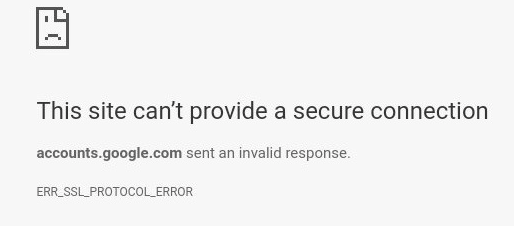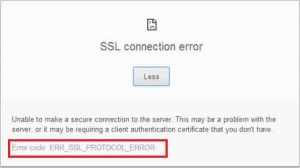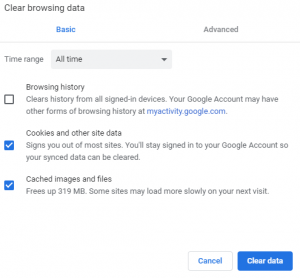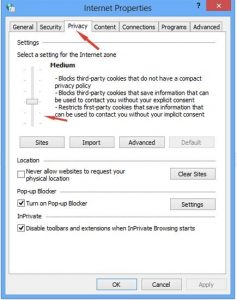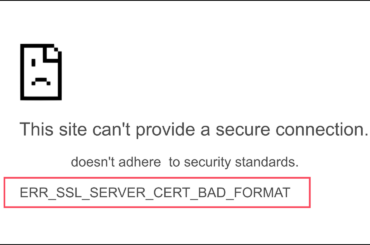Google Chrome is a all-time favorite web browser for users. Like some other internet users, you are likely pleased with the smooth, fast UI and user experience it offers. However, sometimes you may also face the following error while loading a secured site:
The “ERR_SSL_PROTOCOL_ERROR” often message disappears when you refresh the page. But the real headache begins when it remains even after clearing your cache or reloading the page. You can’t ignore this error since almost all popular sites are SSL secured nowadays. Let’s discuss some ways which will help you eliminate this error in Chrome.
8 Ways to Remove the “ERR_SSL_PROTOCOL_ERROR” Message from Your Browser
Sync Your System’s Date
A surprisingly common cause of SSL-related errors is an incorrect system date. When your system’s date is not synced with the date of your desired site’s server, this error occurs in Chrome. The solution is simple: Adjust your system’s date. You can do it manually or by auto syncing with the internet date and time. Try loading the site one more time. The error should disappear. If not, we have seven other solutions for you to try.
Clear Your Browser’s Cache
If you are work in web development, you might’ve seen that CSS changes do not get reflected until you clear the cache. If adjusting the date does not remove the ERR_SSL_PROTOCOL_ERROR from Chrome, try clearing the cache.
- Press Ctrl, Shift and Delete
- Set the time range to “All Time.”
- Check all the checkboxes except “Browsing History.”
- Hit Enter.
Once you have cleared the cache, try reloading the site again:
Restore to Default or Delete the “Hosts” File
There are two methods you can try to restore the hosts’ file. First, You can download the “Host file restore’ tool to fix automatically. If the method doesn’t work, then you can manually create a Hosts file. A default hosts file will be like this, and you can just copy the code mentioned below.
(Instead of directly editing the Hosts file in the root, just copy the ‘hosts’ file from the source and paste it somewhere. Now copy this code and edit the file and remove .txt extension. Now, finally, you can copy this file and paste it in “C:\Windows\System32\drivers\etc\.”)
# Copyright (c) 1993-2009 Microsoft Corp.
#
# This is a sample HOSTS file used by Microsoft TCP/IP for Windows.
#
# This file contains the mappings of IP addresses to host names. Each
# entry should be kept on an individual line. The IP address should
# be placed in the first column followed by the corresponding host name.
# The IP address and the host name should be separated by at least one
# space.
#
# Additionally, comments (such as these) may be inserted on individual
# lines or following the machine name denoted by a ‘#’ symbol.
#
# For example:
#
# 102.54.94.97 rhino.acme.com # source server
# 38.25.63.10 x.acme.com # x client host
# localhost name resolution is handled within DNS itself.
# 127.0.0.1 localhost
# ::1 localhost
You will find a file named hosts in the location “C:\Windows\System32\drivers\etc\.” Maybe it got infected by some malware or a virus, or another application may have modified it somehow. Either way, this results in the file having incorrect information, which may lead the internet connection to redirect the user to unwanted destinations. Deleting it will get rid of the error. If you are using the hosts file for programming, check whether any unwanted piece of code is there. Remove it and the ERR_SSL_PROTOCOL_ERROR from your Chrome browser will disappear.
Clear Your System’s SSL State
If you clear your system’s SSL state, the problem should be resolved:
- Navigate to Chrome Settings. You can do that from the list that appears when you click on the three dots on the top-right corner.
- On the top-left side of your screen, select Settings on the navigation menu. Click on the Advanced drop-down menu and select System.
- Select the option “Open proxy settings.” This will bring up the Internet Properties pop-up window.
- Navigate to the Content tab.
- Select “Clear SSL State.”
Try reloading the site once more. If this didn’t clear the error, keep reading.
Change Your Privacy and Internet Security Settings
All of us are concerned about security when it comes to using the internet. If you’re like many users, this means you may have set your system’s internet privacy and security levels as “High.” This could’ve blocked some SSL connections, thus resulting in the ERR_SSL_PROTOCOL_ERROR in your Chrome browser.
- Go to your system’s Control Panel.
- Navigate to Internet Options.
- Click on the Security tab and change the security level to medium or low.
- Click on the Privacy tab and change security level to medium or low (it will block third party cookies which lacks privacy policy)
4 Ways to Access Internet Options:
- Navigate to ‘tools’ in Internet explorer and click ‘Internet options’
- Go to search bar and search with the phrase ‘Internet options’
- Reach control panel and search with ‘Internet options’
- You can also run command (windows+R) and type control panel and then navigate to ‘Internet options’.
Try reloading the page again. If the error still persists, follow the next steps.
Check and Adjust Your Antivirus Settings
Note: Before trying this step, you should know that doing this will allow the older SSL protocols that are still used by some old websites to go into effect. The job of your antivirus is to keep an eye on wherever you browse and protect you from anything that looks suspicious. If it finds the TLS or SSL protocol of a site are outdated or unsafe, it prevents the site from loading.
Unfortunately, we can’t guide you on how to change the settings because the navigation varies across different antivirus programs. Search in the settings and find out whether your antivirus is scanning the site’s SSL protocols. If it Is, disable the scanning feature. If the problem still continues, revert the settings back to default.
Save up to 85% on trusted SSL certificates
We offer the lowest prices on SSL certificates from Comodo, GeoTrust, Thawte, Sectigo, Symantec, and RapidSSL. Save up to 88% by purchasing direct from us!
Shop Now & Get an SSL Certificate at $4.97
Disable the QUIC Protocol
QUIC, also known as Quick UDP Internet Connections, provides a secured connection to Google’s server. The protocol is the same as SSL or TLS. By default, it is enabled in Chrome. Because of some conflicting issues with the SSL protocol of the site you are about to open, your Chrome browser may show you the ERR_SSL_PROTOCOL_ERROR message. To get rid of it, try the following:
- Type “chrome://flags/#enable-quic” on the address bar and hit the Enter button.
- You will find the QUIC Protocol at the top of your screen.
- If it is set to default, disable it and reload the page.
This is not recommended, but often it resolves the issue.
Enable All TLS/SSL Versions in Your Settings
If none of the above-mentioned solutions worked, it’s time to try the last resort. However, this solution is not at all recommended because it will allow all sites with outdated and insecure SSL protocols to load on your Chrome browser.
The purpose of an SSL protocol is to act as a communication bridge between the server and the user. Suppose the site you are trying to access uses an old SSL protocol — it may not be compatible with Chrome since the latest version of Chrome blocks older or deprecated TLS/SSL protocols. However, there is a way to change it:
- Navigate to Chrome’s Advanced Settings menu and select System.
- Select “Open proxy settings.”
- Click on the Advanced tab.
- Scroll down to Security.
- Check the boxes of all TLS and SSL versions and select Okay.
- Restart your Chrome browser. Now, the “ERR_SSL_PROTOCOL_ERROR” message should be gone.
This solution, as stated before, is for research related purpose only. Like Chrome, all the major browsers have announced that they will stop supporting outdated TLS/SSL protocols for security reasons.
We hope the solutions stated above will help you to get rid of the “ERR_SSL_PROTOCOL_ERROR” message from your Chrome browser. Let us know in the comments if you have used any other solution to resolve the error.
Related Posts
- Install SSL Certificate on NGINX HTTP Server
- Apache Server: Common SSL Errors and Troubleshooting Guide
- Step-wise Guide on Installing a Wildcard SSL on Apache Web Server
- Install SSL Certificate on Amazon Web Services (AWS) in 5 Min
- Enable an SSL certificate in WordPress Multisite Network
- How to Migrate Your WordPress Website from HTTP to HTTPS
- How to install SSL Certificate on Microsoft Exchange Server 2013

